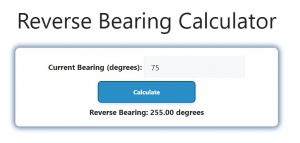About Reverse Bearing Calculator (Formula)
The Reverse Bearing Calculator is an essential tool for navigators, surveyors, and outdoor enthusiasts. It allows users to easily convert a compass bearing into its reverse direction, which is crucial for tasks like plotting courses, determining return paths, and ensuring accurate navigation. Understanding reverse bearings enhances your ability to navigate accurately, whether you are hiking, sailing, or conducting land surveys.
Formula
The formula to calculate the reverse bearing (RB) is:
RB = CB + 180
In this equation:
- RB represents the reverse bearing,
- CB is the original compass bearing, and
- Adding 180 degrees to the compass bearing gives you the reverse direction.
How to Use
Using the Reverse Bearing Calculator is straightforward. Follow these steps:
- Identify your original compass bearing (CB). This value should be between 0 and 360 degrees.
- Plug the compass bearing into the formula RB = CB + 180.
- If the result exceeds 360 degrees, subtract 360 to find the correct reverse bearing.
This method allows for quick calculations that can enhance your navigational accuracy.
Example
Suppose you have a compass bearing of 75 degrees. To find the reverse bearing:
- Compass Bearing (CB) = 75 degrees
- Using the formula:
RB = 75 + 180
RB = 255 degrees
So, the reverse bearing is 255 degrees. If you had a bearing of 210 degrees:
- RB = 210 + 180 = 390
- Since 390 exceeds 360, subtract 360:
RB = 390 – 360 = 30 degrees
Thus, the reverse bearing for 210 degrees is 30 degrees.

FAQs
- What is a bearing?
A bearing is a direction or angle measured in degrees from a reference direction, typically north. - Why do I need to calculate reverse bearings?
Reverse bearings are useful for plotting return paths and ensuring accurate navigation. - Can the original compass bearing (CB) be negative?
No, compass bearings range from 0 to 360 degrees. - What if my calculated reverse bearing exceeds 360 degrees?
Simply subtract 360 degrees to find the correct reverse bearing. - How is the reverse bearing used in navigation?
It helps in determining the direction to return to a starting point or to align with a different course. - Can I use this calculator for any type of navigation?
Yes, it is applicable in maritime, aeronautical, and land navigation. - What tools can I use to measure compass bearings?
A compass, GPS device, or navigational app can be used to measure bearings. - Is the reverse bearing the same as a reciprocal bearing?
Yes, reverse bearing and reciprocal bearing refer to the same concept. - How can I ensure accuracy when using the calculator?
Always check your initial bearing and ensure it is within the 0 to 360-degree range. - What happens if I use a bearing of 0 degrees?
The reverse bearing would be 180 degrees, pointing in the opposite direction. - Are there applications for reverse bearings in surveying?
Yes, surveyors use reverse bearings to ensure accurate property boundary mapping. - How does this calculator benefit sailors?
It allows sailors to quickly determine the course to return to their starting point after navigating away. - Can reverse bearings be used for GPS navigation?
Yes, they can enhance GPS navigation by providing return route options. - What if I have a bearing of 360 degrees?
The reverse bearing would be 180 degrees, as it is equivalent to 0 degrees. - Can I use the reverse bearing for land-based navigation?
Yes, it is equally effective for navigating through land, such as in hiking. - What are some common mistakes when calculating reverse bearings?
Common mistakes include not subtracting 360 when exceeding 360 degrees and misreading compass bearings. - Is there a difference between true north and magnetic north?
Yes, true north is the geographic North Pole, while magnetic north is the direction a magnetic compass points, which can vary based on location. - How precise do I need to be when measuring bearings?
Precision depends on the activity; for navigation, aim for accuracy within a few degrees. - Can I calculate reverse bearings mentally?
Yes, with practice, many can do quick calculations, especially for common bearings. - What is the importance of reverse bearings in safety?
They are crucial for ensuring navigators can safely return to a starting point, particularly in wilderness or maritime settings.
Conclusion
The Reverse Bearing Calculator is an essential tool for anyone involved in navigation, whether on land or at sea. By using the simple formula RB = CB + 180, you can quickly determine reverse bearings to enhance your navigational skills. Understanding how to calculate and apply reverse bearings is vital for accurate navigation, ensuring that you can find your way back safely and effectively, no matter where your journey takes you.
